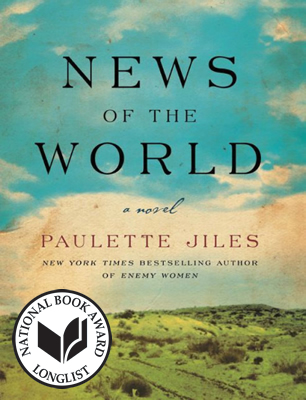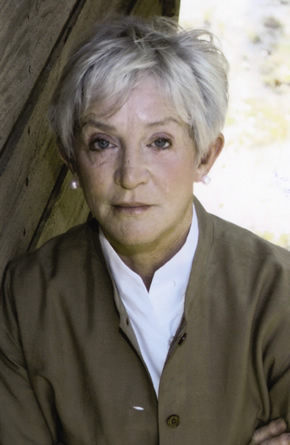2017
The News of the World by Paulette Jiles
 1870, North Texas, rainy and cold. Captain Jefferson Kyle Kidd travels from town to town giving readings from the latest newspapers, bringing the news of the world to isolated towns on the Texas frontier. In Wichita Falls, he is asked to return a captive girl to her relatives near San Antonio, 400 miles to the south. The old man and the ten-year-old start out on a hazardous journey, no less risky because the girl considers herself now a Kiowa and does not have the slightest desire to return. Bandits and Comanche raids and violent weather make as many difficulties as the ten-year old girl who can’t speak English, eats with her hands and knows how to use a revolver. In the end, he finds he must return her to relatives who don’t want her, even though he and the girl have become trusting friends. A story of courage and honor and the truth that these two things are often the possession of even the unlikeliest people.
1870, North Texas, rainy and cold. Captain Jefferson Kyle Kidd travels from town to town giving readings from the latest newspapers, bringing the news of the world to isolated towns on the Texas frontier. In Wichita Falls, he is asked to return a captive girl to her relatives near San Antonio, 400 miles to the south. The old man and the ten-year-old start out on a hazardous journey, no less risky because the girl considers herself now a Kiowa and does not have the slightest desire to return. Bandits and Comanche raids and violent weather make as many difficulties as the ten-year old girl who can’t speak English, eats with her hands and knows how to use a revolver. In the end, he finds he must return her to relatives who don’t want her, even though he and the girl have become trusting friends. A story of courage and honor and the truth that these two things are often the possession of even the unlikeliest people.
News of the World |
Paulette Jiles reads from News of the World, 2016 NBAs Finalists Reading |
El Paso by Winston Groom
Pitting the legendary Pancho Villa against "the Colonel," a thrill-seeking Bostonian railroad tycoon whose fading fortune is tied up in a colossal ranch in Chihuahua, El Paso opens during a time of dramatic upheaval in Mexico--its government being squeezed on one end by Villa's revolutionaries and on the other by "filthy" American capitalists.
The Boy in His Winter: an American Novel by Norman Lock
Huck Finn and Jim float on their raft across a continuum of shifting seasons, feasting on a limitless supply of fish and stolen provisions, propelled by the currents of the mighty Mississippi from one adventure to the next. Launched into existence by Mark Twain in 1835, they have now been transported by Norman Lock through three vital, violent, and transformative centuries of American history. As time unfurls on the river's banks, they witness decisive battles of the Civil War, the betrayal of Reconstruction's promises to the freed slaves, the crushing of the Native American nations, and the electrification of a continent.
The Barkskins by Annie Proulx
In the late seventeenth century two penniless young Frenchmen, René Sel and Charles Duquet, arrive in New France. Bound to a feudal lord, a " seigneur ," for three years in exchange for land, they become wood-cutters--barkskins. René suffers extraordinary hardship, oppressed by the forest he is charged with clearing. He is forced to marry a Mi'kmaw woman and their descendants live trapped between two inimical cultures. But Duquet, crafty and ruthless, runs away from the seigneur, becomes a fur trader, then sets up a timber business. Proulx tells the stories of the descendants of Sel and Duquet over three hundred years--their travels across North America, to Europe, China, and New Zealand, under stunningly brutal conditions--the revenge of rivals, accidents, pestilence, Indian attacks, and cultural annihilation.
Quiet Until the Thaw by Alexandra Fuller
Two Native American cousins, Rick Overlooking Horse and You Choose Watson, though bound by blood and by land, find themselves at odds as they grapple with the implications of their shared heritage. When escalating anger toward the injustices, historical and current, inflicted upon the Lakota people by the federal government leads to tribal divisions and infighting, the cousins go in separate directions: Rick chooses the path of peace; You Choose, violence.
Far as the Eye Can See by Robert Bausch
Bobby Hale is a Union veteran several times over. After the war, he sets his sights on California, but only makes it to Montana. As he stumbles around the West, from the Wyoming Territory to the Black Hills of the Dakotas, he finds meaning in the people he meets-settlers and native people-and the violent history he both participates in and witnesses. Far as the Eye Can See is the story of life in a place where every minute is an engagement in a kind of war of survival, and how two people-a white man and a mixed-race woman-in the midst of such majesty and violence can manage to find a pathway to their own humanity.
Dodge City: Wyatt Earp, Bat Masterson, and the Wickedest Town in the American West by Thomas Clavin
Dodge City, Kansas, is a place of legend. The town that started as a small military site exploded with the coming of the railroad, cattle drives, eager miners, settlers, and various entrepreneurs passing through to populate the expanding West. Before long, Dodge City's streets were lined with saloons and brothels and its populace was thick with gunmen, horse thieves, and desperadoes of every sort. By the 1870s, Dodge City was known as the most violent and turbulent town in the West. Enter Wyatt Earp and Bat Masterson. Young and largely self-trained men, the lawmen led the effort that established frontier justice and the rule of law in the American West, and did it in the wickedest place in the United States.
Race and Reunion : the Civil War in American Memory by David W. Blight
No historical event has left as deep an imprint on America's collective memory as the Civil War. In the war's aftermath, Americans had to embrace and cast off a traumatic past. David Blight explores the perilous path of remembering and forgetting, and reveals its tragic costs to race relations and America's national reunion.
How the World Moves : the Odyssey of an American Indian Family by Peter Nabokov
Born in 1861 in New Mexico's Acoma Pueblo, Edward Proctor Hunt lived a tribal life almost unchanged for centuries. But after attending government schools he broke with his people's ancient codes to become a shopkeeper and controversial broker between Indian and white worlds. As a Wild West Show Indian he travelled in Europe with his family, and saw his sons become silversmiths, painters, and consultants on Indian Lore. In 1928, in a life-culminating experience, he recited his version of the origin myth of Acoma Pueblo to Smithsonian Institution scholars.
The Wars of Reconstruction : the Brief, Violent History of America's Most Progressive Era by Douglas R. Egerton
By 1870, just five years after Confederate surrender and thirteen years after the Dred Scott decision ruled blacks ineligible for citizenship, Congressional action had ended slavery and given the vote to black men. That same year, Hiram Revels and Joseph Hayne Rainey became the first African-American U.S. senator and congressman respectively. In South Carolina, only twenty years after the death of arch-secessionist John C. Calhoun, a black man, Jasper J. Wright, took a seat on the state's Supreme Court. Not even the most optimistic abolitionists had thought such milestones would occur in their lifetimes. The brief years of Reconstruction marked the United States' most progressive moment prior to the civil rights movement.
Frontier Blood: the Saga of the Parker Family by Jo Ella Powell Exley
Drawing on a wealth of contemporary accounts, including several first-person stories, Jo Ella Powell Exley follows Cynthia Ann-Parker--a descendant of Elder John Parker--last of the great Comanche war chiefs-- through her life in the Indian camp and eventually her recapture by her birth family. She also tells the dramatic story of Quanah Parker through childhood, battle, surrender, and reservation life. This narrative sets straight a story that has sometimes been distorted, offering new insight of Cynthia Ann Parker's last years, providing a complex picture of the "white" years of a woman who had matured among the Comanches since the age of nine.

 Paulette Jiles is a novelist, poet, and memoirist. She is the author of Cousins, a memoir, and the novels Enemy Women, Stormy Weather, The Color of Lightning, Lighthouse Island, and News of the World. She lives on a ranch near San Antonio, TX.
Paulette Jiles is a novelist, poet, and memoirist. She is the author of Cousins, a memoir, and the novels Enemy Women, Stormy Weather, The Color of Lightning, Lighthouse Island, and News of the World. She lives on a ranch near San Antonio, TX.


